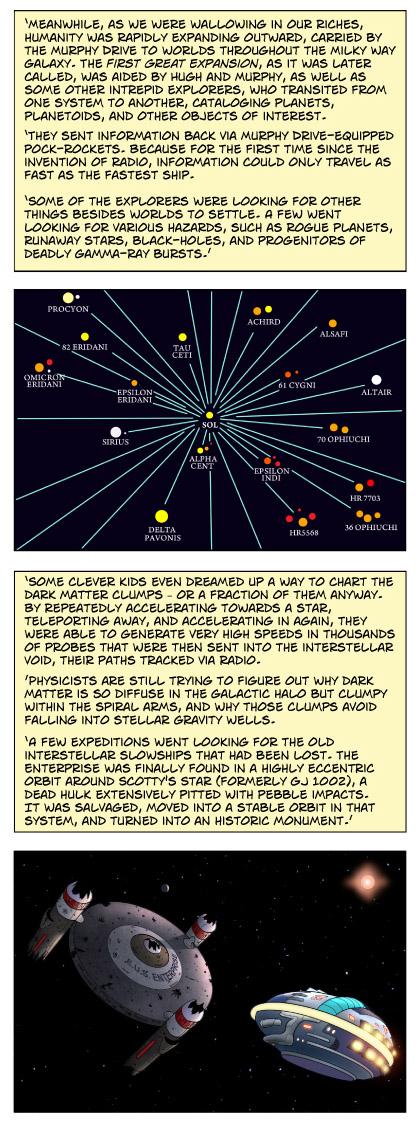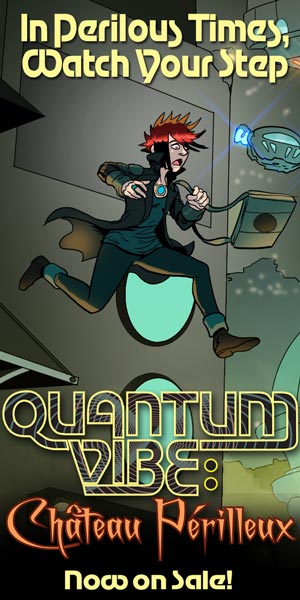Strip 1093 - Click strip above to goto the next strip.
First Seen: Wed 2015-05-13
Story & Art: Scott Bieser - Colors: Lea Jean Badelles
Sci-Fi Adventure Monday & Thursday.
Quantum Vibe
A thousand years in the future, humanity has colonized worlds in nearly 100 galaxies, thanks to Quantum Vibremonic technologies developed five centuries earlier. Other new technologies have created various off-shoots of humanity and extended life expectancies five-fold. The story begins with how a mad scientist and his plucky assistant, along with their robot friend, brought humanity to the stars, and continues with the adventures of some unique people in fantastic places.
One Dollar Sale Continues! [ Jun 24, 2025 ]

Hard to believe it, but Big Head Press published it's first novel, over 20 years ago. To commemorate our stubborn longevity, we continue to stubbornly offer each of our non serialized graphic novel stories for just one mere American dollar (plus shipping). Start your holiday shopping early and light up some body's mind with one or more of these titles.
Offer only available in the United States.
Transcript For Strip 1093
Panel 1Text panel, with a cameo of Nicole again as she continues the narration.
Caption: 'Meanwhile, as we were wallowing in our riches, humanity was rapidly expanding outward, carried by the Murphy Drive to worlds throughout the Milky Way galaxy. The First Great Expansion, as it was later called, was aided by Hugh and Murphy, as well as some other intrepid explorers, who transited from one system to another, cataloging planets, planetoids, and other objects of interest.
They sent information back via Murphy Drive-equipped pock-rockets. Because for the first time since the invention of radio, information could only travel as fast as the fastest ship.
Some of the explorers were looking for other things besides worlds to settle. A few went looking for various hazards, such as rogue planets, runaway stars, black-holes, and progenitors of deadly gamma-ray bursts.'
Panel 2
Tactical schematic with the Sol System at the center, and vector lines representing Murphy-Drive ships transiting out to the surrounding stars.
No dialog
Panel 3
Text panel
Caption: Some clever kids even dreamed up a way to chart the dark-matter clumps – at least those near Sol and the other more significant star systems. By repeatedly accelerating towards a star, teleporting away, and accelerating in again, they were able to generate very high speeds in thousands of probes that were then sent into the interstellar void, their paths tracked via radio.
Physicists are still trying to figure out why dark-matter behaves the way it does. Why it is so diffuse in the galactic halo but clumpy within the spiral arms, and why those clumps avoid falling into stellar gravity wells. Maybe some day they'll figure it out.
A few expeditions went looking for the old interstellar slowships that had been lost. The Enterprise was finally found in a highly eccentric orbit around Scotty's Star (formerly GJ 1002), a dead hulk extensively pitted with pebble impacts. It was salvaged, moved into a stable orbit in that system, and turned into an historic monument.
Panel 4
The Enterprise (from strip 1-188), looking very much the worse for wear, being discovered by a Murphy ship. The red dwarf star GJ 1002 in the distance.
No dialog
Web-comics Scott Reads
SPACETRAWLERGrrl Power
Schlock Mercenary
Unsounded
Diesel Sweeties
Girl Genius
XKCD
Drive
Day By Day
Saturday Morning Breakfast Cereal
Questionable Content
Gunnerkrigg Court
Something * Positive
Oglaf (NSFW)
Trekker
HELM
POWERNAP
For news and reviews:
The Beat
Bleeding Cool
Comics Worth Reading
Framing Graphics © 2024 Big Head Press


















